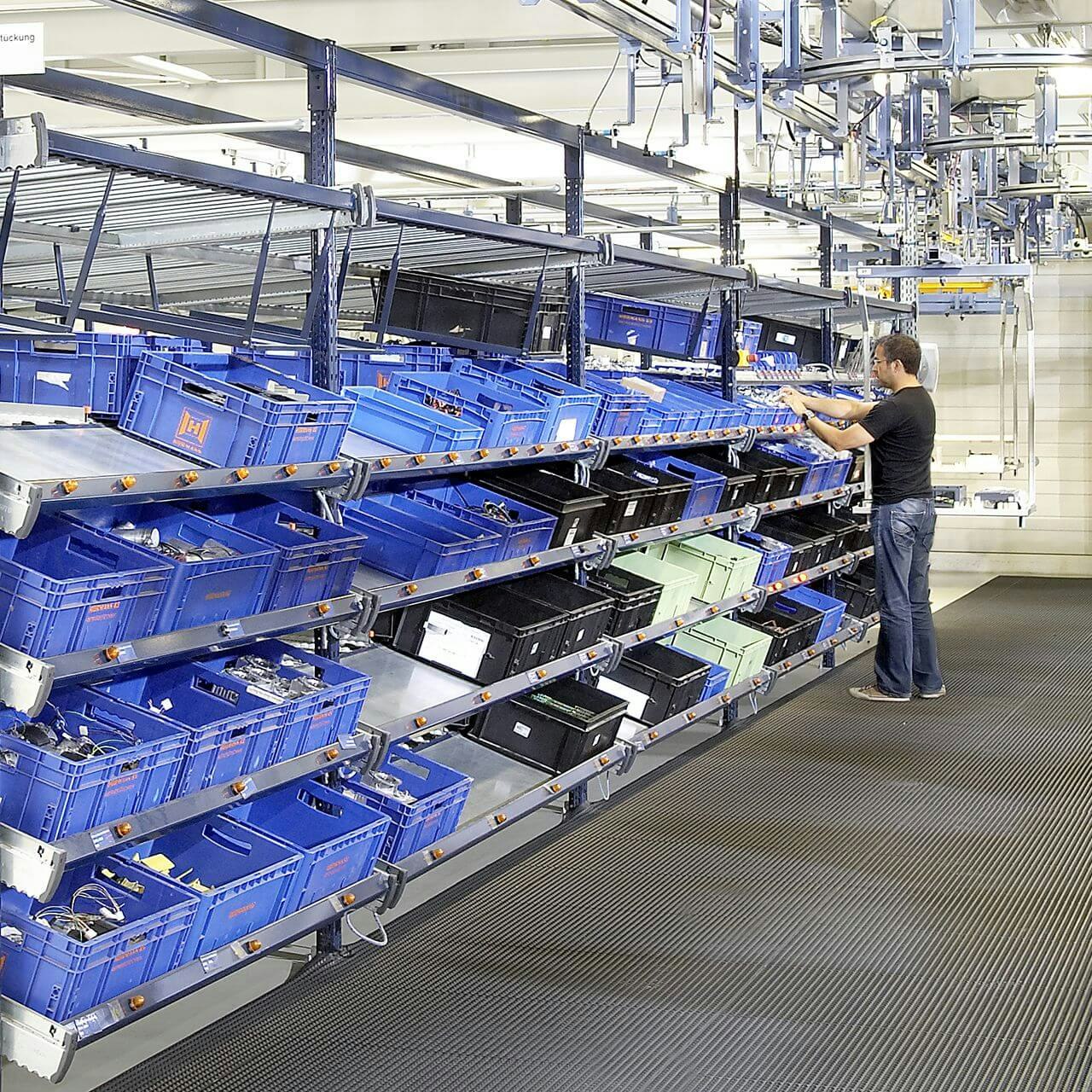Black Week: Optimising picking for periods of peak sales

The event called Black Friday (1) originated in the USA and was intended to increase retail sales at the beginning of the Christmas shopping season. For some retailers, it is also referred to as the point when they go into the black and start making a profit. Black Friday falls on the Friday after the Thanksgiving holiday which is celebrated on the fourth Thursday in November in the USA. Over time, many countries have adopted Black Friday and it has also been extended to become Black Week. The discounts and sales now extend from the Monday before Black Friday to the so-called Cyber Monday.
An influx of orders leads to challenges in the warehouse
Black Week, like other peak sales periods, leads to an enormous challenge for companies and their logistics, which have to cope with the flood of orders in a short time. Particularly affected are the entire logistics, the warehouse and especially order picking (2) as well as the supply area. This naturally raises the question of how the warehouse or order picking can cope with the sudden increase in orders. How can a company adjust to such peak times in sales? Which picking types and methods are suitable? How can an optimal warehousing system be set up in the company? What about the automation of processes in general?
How can picking be optimised?
In order to cope with the sudden increase in orders, the processes in the company and warehouse should be easily scalable. In a manual warehouse, this means first and foremost that additional employees and possibly picking stations have to be provided. Here, extra staff are often hired through temporary employment agencies, however, they have to be trained very quickly, which contributes to the frequency of errors in the manual warehouse or manual picking.
The advantages of automated processes and warehouses are the speed of order processing, the higher throughput, the lower error frequency and the easier scalability. Manual warehouses without flow racking (3) also often work according to the man-to-goods principle, which leads to greater strain on employees. Automated warehouses work on the goods-to-man principle, which is much more ergonomic and takes a lot of strain off the staff. However, the e-commerce sector is not well suited for full automation of the warehouse due to the large range of products often with a low number of picks. Partial automation of processes by means of stocking and picking robots, cobots and automated guided vehicles (AGVs) can often be useful here for optimisation in the warehouse.
Advantages of a warehouse management system
The introduction of a warehouse management system (WMS) is generally worthwhile and leads to better transparency of stocks and optimisation of warehousing. A WMS forms the basis for automated solutions and also enables chaotic storage location allocation. A WMS offers many advantages such as simplified, efficient warehouse management and control, increased efficiency, reduced error rates and increased process reliability. Furthermore, the WMS leads to a fast data exchange, short reaction times as well as adaptation and flexibility of the operation. Furthermore, it enables the networking of branches and subsidiaries and the optimal reconciliation of stocks.
Choosing the right picking method
When it comes to the efficiency of the picking process, minimising the picking times (travel time, pick time, dead time, distribution time, 4, 5) through organisational and technical measures plays a major role. In goods-to-man systems, the travel time is of course zero. RFID transponder technology is also increasingly being used in order picking. One reason for this is automation and digitalisation within the framework of the Industry 4.0 standard. Special picking processes such as Pick-by-Light, Pick-by-Voice, Pick-by-Terminal, Pick-by-MDE and Pick-by-Point® are moving into order picking. Pick-by-Light and Pick-by-Voice systems in particular offer great potential for optimisation and better ergonomics for the order picker. Pick-by-Voice is a paperless and voice-controlled picking process. The solution allows the picker to focus completely on picking. In addition, their hands remain free for the picking process. The WMS transmits the pick orders via voice client, the picker confirms the pick, which is reported directly back to the WMS. This eliminates time-consuming searches, reduces error rates and optimises picking performance.
If you use storage systems based on the man-to-goods principle, then you should arrange the goods according to the level of demand. Fast-moving items should be stored as close as possible to the picking stations. In general, it is also worthwhile to optimise stock (3, 6) and to plan sales in advance (see below). The items should also be organised in product classes to avoid long searches. If warehousing is already organised and controlled with a WMS, the system usually also takes over route optimisation for efficient picking.
One-step and two-step picking
When picking in the warehouse, different methods of order composition are used: order-oriented serial or parallel (single-stage picking), series-oriented parallel (two-stage or multi-stage picking). Manual or automated picking systems are also used.
Series-oriented, parallel order combination is particularly suitable for high volume orders (more than 1000) with few items (1 to 5) - i.e. especially for e-commerce. With this solution, identical items from different orders are combined into series and processed in parallel in different storage zones. This drastically reduces the number of accesses to an item and also the distance involved in the picking process. Several orders are combined into a total order, then picked article-oriented and only later distributed and packed order-oriented. This makes it possible to optimise the picking tours of the order picker for each article. Other factors such as storage area, weight, volume and quantities are also taken into account. Of course, the articles can also be fed according to the goods-to-man principle or picked with picking robots. After picking, an efficient sorting process is necessary so that the respective article can be returned to the corresponding order. However, the required sorting and distribution systems (sorters) are quite costly. The efficiency of two-stage or multi-stage picking is much higher than with single-stage picking.
Use predictive sales planning with AI
Artificial intelligence (AI) software solutions exist for inventory and picking optimisation to adjust stock levels to fluctuating demand. Based on sales figures from previous periods and incorporating statistical methods, the optimal order quantity for a specific period is automatically calculated (predictive planning & forecasting). Seasonal fluctuations are included in the forecast, with spontaneous changes in demand being smoothed out by algorithms. If a very high level of service is to be achieved and thus the immediate execution of a large number of orders is to be ensured, the safety stocks in the warehouse must be correspondingly large (6). In general, this allows a company to adjust much better to peak times.
Literature:
1 Black Friday, Wikipedia, Link
2 BITO Briefing, Warehouse picking, Link
3 BITO, Checklist "Tips for increasing productivity and warehouse performance", Link
4 BITO Briefing, More efficiency through paperless order picking Link
5 Order picking, Luca Logistics Solutions, Link
6 BITO Briefing, Optimise your delivery performance, Link


